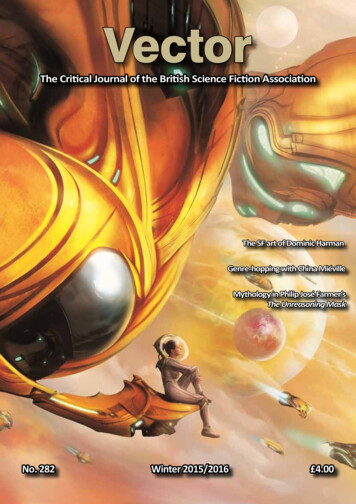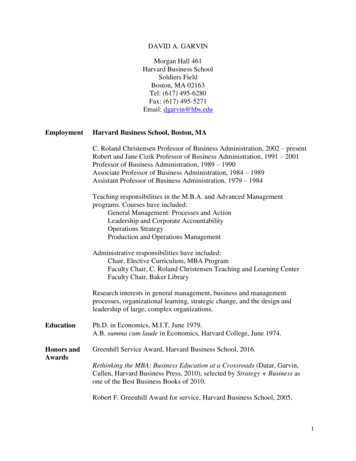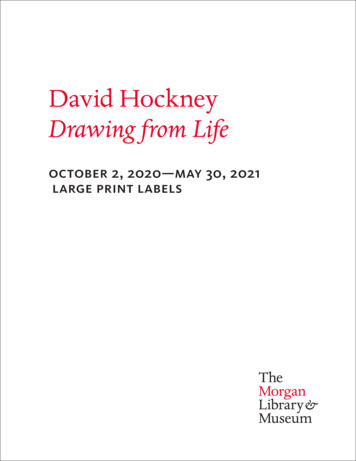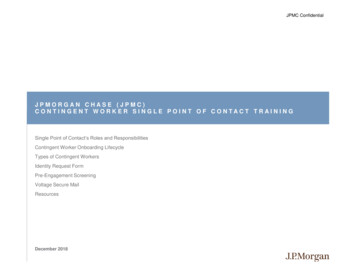
Transcription
VectorThe Critical Journal of the British Science Fiction AssociationThe SF art of Dominic HarmanGenre-hopping with China MiévilleMythology in Philip José Farmer’sThe Unreasoning MaskNo. 282Winter 2015/2016 4.00
VectorThe Critical Journal of the British Science Fiction AssociationVectorARTICLESTorque ControlEditorial by Glyn Morgan . 3http://vectoreditors.wordpress.comFeatures, EditorialDealing With Dragons:and Letters:The Art of Dominic HarmanAn interview with our cover artistby Anna McFarlane . 4Co-Editor:A Novel in Every GenreBook Reviews:Classifying the work of China Miévilleby Rob O’Connor . 10Mythological Speculation in Philip JoséFarmer’s The Unreasoning MaskDavid Mitchell in Conversation withby Michael O’Brien . 16RECURRENTKincaid in Short: Paul Kincaid . 23Sequentials: Laura Sneddon . 26Foundation Favourites: Andy Sawyer . 30Resonances: Stephen Baxter . 32THE BSFA REVIEWProduction:Glyn Morgan35 Belgrave Road,Aigburth,Liverpool L17 7AGvector.editors@gmail.comAnna McFarlaneMartin Petto27 Elmfield Road,Walthamstow E17 7HJmartin.lewis@gmail.comAlex BardyBSFAmags@mangozine.comBritish Science Fiction Association LtdThe BSFA was founded in 1958 and is a non-profitmakingorganisation entirely staffed by unpaid volunteers.Registered in England. Limited by guarantee.BSFA Websitewww.bsfa.co.ukCompany No. 921500Registered address: 61 Ivycroft Road, Warton, Tamworth,Staffordshire B79 0JJPresidentStephen BaxterChairTreasurerDonna Scottchair@bsfa.co.ukMartin Potts61 Ivy Croft Road, Warton,Nr. Tamworth B79 0JJbsfatreasurer@gmail.comMembership Services Dave Lally(incl. changes of address) membership@bsfa.co.ukThe BSFA Reviewedited by Martin Petto . 35MEMBERSHIP FEESIn this issue, Paul Kincaid enjoys a visit to Europe AtUK 29 per annum (Unwaged: 20 pa)Life Membership 500Midnight, Donna Scott learns a thing or two aboutOutside UK 40the Memory of Water, and Dave M Roberts toodlesJoint/Family MembershipAdd 2 to the above pricesalong to see the Mother of Eden. Meanwhile, DanCheques (Pounds Sterling only) should be made payable toHartland’s adventures in The Fifth Dimension are‘BSFA Ltd’ and sent to Martin Potts at the address above, orjoin via the BSFA website using Paypal at www.bsfa.co.ukruined by L J Hurst’s The Rabbit Back LiteratureSociety, determined to send him back via KarenFOCUS: THE BSFA MAGAZINE FOR WRITERSEditor:Dev ArgawalBurnham’s Deep Time to complete his training atdevhotmail@yahoo.co.ukSusan Oke’s prestigious Fencing Academy.BSFA AWARDSAdministrator:Published by the BSFA Ltd 2015 . ISSN 05050448All opinions expressed are those of the individual contributors andnot BSFA Ltd except where expressly stated. Copyright of individualarticles remains with the author.Farah Mendlesohnawards@bsfa.co.ukORBITER WRITING GROUPSOnline:Terry Jackmanterryjackman@mypostoffice.co.ukpage 2
VECTOR #282 – Winter 2015/2016Torque ControlÊtes-vous Parisien?The world’s gaze has been fixed on Paris of late. The nationwhich gave us Louis Geoffroy (author of the first alternatehistory novel), Jules Verne, Georges Méliès, Gilles Thomas,Roland C. Wagner, Jacques Tardi, and so many others, hasentranced us with alternating images of dystopia, and (if notutopia) hope for something better.1The attacks were assaults on normal people having anormal Friday night, they were designed to shake not justthe French idea of security and normality, but that of citizensof nations throughout what we call the Western World. Youknow the details. Of course you do. The news was total in itscoverage and penetration, and yet for all the horrific storiesand images which would emerge there was a strong elementof Jean Baudrillard (another Frenchman) and the simulacraabout it. Through social media people expressed opinions,attacked other opinions, and defended hypotheticals. Eventssuch as the Paris attacks expose just how much we’ve come torely on social media not only for news or keeping in touch, butto express and process our emotional responses. This seemsvery science fictional to me.If the Paris attacks and the quagmire-like war in Syriaprovoked feelings of dystopia in me, then some of theexpressions of defiance that we saw on the streets in Francebrought something of a sniff of optimism for humanity. Thiswas enhanced, perhaps naively on my part, by the massiveclimate summit that followed only two weeks later. Thatthe event went ahead at all, and that so many thousands ofnormal people took to the streets (eventually, after somerather interesting ‘absent protests’ following an initialblanket ban on public gatherings), is itself remarkable. Asmy interview with David Mitchell last issue alluded to, thecataclysm of post-oil, coupled with climate change, are thebiggest threats of civilization that we face, no matter whathappens in the Middle East. That nearly 200 nations managedto agree on something which, even if too little too late, couldreally impact climate change, is astounding. As a child of StarTrek, this sort of diplomatic consensus seems very sciencefictional to me.So I’ve been thinking a lot about France recently (I don’treally follow the round-ball sport but I was happy to noteWales will join the two Irish teams and England at the European Cup next summer). I’ve been thinking about the romanceattributed to the place, and the steampunk cool we’veoften gifted it. I’ve been thinking about Woody Allen’s timetraveling Midnight in Paris, Gareth Powell’s [BSFA Awardwinning] Ack-Ack Macaque. Paris is a place which bewitchespopular culture from Casablanca to China Miéville’s forthcoming book, The Last Days of Paris.There’s plenty of Miéville in this issue as Rob O’Connortackles the issue of genre classification and China’s books.I’ve often heard it said that genre is just something bookshops create so that they can market (and organise) books.Even if this is true, don’t think that booksellers themselvesaren’t just as annoyed at what gets into the science fictionsection and what doesn’t, Rob’s article begins with just sucha complaint and I too have smuggled extra copies of Atwood,Susannah Clarke, Chabon, Vonnegut and more, around thecorner from general fiction to science fiction.MichaelO’Brien’s article tackles another genre-bending novel,although in different ways, as he reminds us of Philip JoséFarmer’s The Unreasoning Mask and its blending of religiousmythology with science fiction.There’s so much more in this issue of Vector that I thinkyou’ll enjoy but in the space left to me I want to highlight oneof our regular columns: Laura Sneddon’s article venturesonto the other topic I considered turning the bulk of myeditorial over to, a certain film which is causing quite a stir.By the time this reaches print many of you will have seen TheForce Awakens, no doubt, but just in case I’ll avoid specifics. All I’ll say is that it too gave me a reason for hope andoptimism this month. It’s not a perfect film, although a damnsight better than the prequels, but it gives me [A New?] hopefor the future of Star Wars, and more importantly it excitedme to see a confident blending of old and new arms of thefranchise and the confident and self-assured steps forwardtaken by its leads: a young woman and a man of colour. Couldit be that Hollywood has reached a maturity we could onlytalk about hypothetically not all that long ago? Hopefully, orperhaps that too should seem science fictional to me.1. On the topic of “so many others” – everyone knows France has a rich tradition ofscience fiction, but it astonishes me how little of it we know, or is even translatedinto English (how many winners of the Prix Rosny-Aîné can you name?). I supposetranslation is expensive and the English language produces such a quantity ofscience fiction that publishers don’t need to seek out French works. There are,after all, strong science fiction/ fantasy traditions in other languages that we seejust as little of in our Anglophone bubble, see our recent interviews on Latvian SFand more. If anyone wants to write some articles about French SF and send themto us then please do!Tweet about Vector,use the hashtagAnna McFarlaneand Glyn MorganCo-Editors, Vector#sfVectorCover art by Dominic Harmanfrom Solaris’sThe Best of SF & Fantasy Vol 9 (2015)Website: http://www.dominic-harman.com/Please submit all articles, comments and queries to vector.editors@gmail.compage 3
VECTOR #282 – Winter 2015/2016Dealing With Dragons:The Art of Dominic HarmanAn interview by Anna McFarlaneThe cover of Vector #282 has been kindly provided byartist Dominic Harman, and is also the cover of TheBest Science Fiction and Fantasy of the Year VolumeNine from Solaris (2015, edited by Jonathan Strahan). Hehas designed artwork for Clive Barker’s novels with HarperCollins and the Philip Pullman His Dark Materials boxset among many, many others as well as working on albumcovers for bands like Insane Clown Posse. I spoke to Dominicabout his artistic process, and how he came to the field ofscience fiction, fantasy, and horror.Anna McFarlane: Hi Dominic, thanks for agreeing tospeak to Vector, and thanks for letting us use your artworkon our cover for this issue.Dominic Harman: First, let me say how happy I am tobe interviewed by Vector! Many thanks to yourself andDonna Scott, I appreciate it very much! Well, regardingthis month’s cover, I was given the opportunity to illustrate the cover for Solaris’ Best of SF & Fantasy of the Year.Vol. 9. I discussed ideas with the publishers and editorsand we agreed that it was important to have a humanelement in there amongst all the vast, soaring technology.We went for a convoy of cruisers with the pilot of one ofthem sitting for a moment taking in the beautiful pastelpanorama with gas giants and smaller satellites surrounding them in the heavens.AM: It looks great: first let me ask you, what’s your background and how did you begin illustrating professionally?DH: As a child, like all children I guess, I was drawingand sketching. I remember seeing in my early teens thealbum covers of the rock band Iron Maiden, illustrated byDerek Riggs. I was so impressed by the intense energy ofhis artwork that I studied the covers corner to corner. Hewas my first major influence. Later, I discovered the worksof Boris Vallejo with his stunning book, Mirage, and FrankFrazetta, through his 1960s Conan book covers for Lancer.Those artists were hugely influential on me and paved theway for my career in SF and Fantasy illustration.My first professional sale was to Interzone magazine in1997 and since then I have worked for all the major publishers, illustrating book covers and calendar pieces forauthors and bands such as Terry Pratchett, Philip Pullman,Clive Barker, Ursula. LeGuin, Jack Finney, Frank Herbert,Insane Clown Posse, Justina Robson, Ian Whates, EricBrown, Naomi Novik, and H.G. Wells to name a few.AM: What about the classical artistic tradition, do youfind much inspiration there?DH: I mentioned earlier my contemporary inspirationsand influences but I was also inspired by the old masterssuch as Velazquez, Rembrandt, Rubens and Caravaggio.I remember going to the National Gallery in London andbeing in total awe of these masters, it was an experience Ihave never forgotten and when I go back its very much thesame. I would suggest to people who haven’t been thereyet to go. Regardless of the subject matter, the sheer scaleof some of them is quite something to behold. Some yearsback I went to Florence, Italy to study Caravaggio in aworkshop with an Atelier Academy. It felt like a pilgrimageto walk in the footsteps of the masters and to study theirtechniques.AM: And have these inspirations had an impact on yourmaterial practice as an artist, then?DH: Well, I began painting in watercolour but I seriouslygot into using oil and graphite: I then started using an airbrush with Acrylic when I was experimenting with newmediums, but when I first started getting into the business in the late 90s I saw that computers were quicklygrowing in popularity and the book cover market wasrapidly turning to digital cover artwork. it was an agonising choice but I realised that the best way forward for mecommercially was to embrace digital art and computers.I still paint and draw traditionally as it’s a very importantdiscipline a passion and balance to the professional illustration and all that comes with it.AM: Can you describe a working day in your life for us?DH: Well, preparing for a day’s work at the computer (oreasel) I always start with music as it’s very important tocreate a good working environment. It’s much easier to getthe creative juices flowing with a beautiful score playinglike Jerry Goldsmith (Alien), Basil Poledouris (Conan theBarbarian, Robocop), Vangelis (Bladerunner) and TangerineDream (Phaedra, Legend) and it’s exciting to purchase filmscores from films I haven’t seen so I am not thinking of aspecific scene from a film. Recently I have been enjoyingpage 4
VECTOR #282 – Winter 2015/2016AM: Is it easier when you have more information, or doyou prefer having a free reign?DH: It all depends; it’s great to have free reign and othertimes I have a specific brief but I still enjoy illustrating acover within those parameters. I think a balance is important in order to keep things fresh.AM: What are you trying to achieve when you illustratea story or an album? What do you feel your work adds tothe experience of reading the literature or hearing themusic?podcasts, everything from interviews with musicians,mainly from the 80s rock and metal genres, and crimedocumentaries, anything from Mafia to physiological toAndrew Graham-Dixon’s fascinating art documentaries inwhich he examines various artists within their time andplace and their styles.AM: How do you begin designing artwork for a specificproject, book/CD?DH: I have developed two styles over the years, it differsa little. For example, the cover art for Patricia C. Wrede’sDealing with Dragons. I started with digital roughs ingrayscale to compose and deal with lighting and designing the characters. Then I will colour it up by creating apalette that is suitable for the subject and mood. Colouris the last thing for the rough. Once a particular rough ischosen I will begin to work it up. Occasionally that mayinvolve photo reference but as its cartoon-realism sometimes it will just be made up. For the cover of Jo Anderton’sDebris for example, I created a rough in the same way asbefore but as this style is photorealisitic I will book in aphotoshoot and will use my photos directly along with my3D and Photoshop skills to create the cover.AM: And what information are you given in advance forsuch projects? Do you get early access to the text?DH: On occasion I get to read the novel/short story andsometimes I get a brief, the latter is what happens mostlythese days. I like to do both but often there isn’t the timeso I am given a specific scene. I am happy to do both.DH: Good question. Well, something arresting and eyecatching of course – on the covers I did for Darren Shan,the monsters are literally jumping out at the reader topummel them into submission! That approach really fittedthe explosive, fast-paced style of Darren’s superb writing.For the guitar virtuoso Borislav Mitic’s album, ElectricGoddess, it required a more understated approach, wherethe viewer is drawn in by the cover, a woman’s face andheaddress made out of mechanical parts with sensualundercurrents. In this case it’s where the art and musicweave a harmonious feeling. Both approaches are a lot offun!AM: Have you always been a fan of fantasy, sciencefiction, and horror?DH: Yes, absolutely! I remember when I was a childseeing on TV the 1950s version of Invaders from Mars andthat spooky picket fence on top of the hill! Also seeing JohnCarpenter’s The Thing. That scared the life out of me butthe interesting thing was I went back to watch the filmpage 5
VECTOR #282 – Winter 2015/2016again and again, I was fascinated with how a film couldhave the power to really scare you so much but also theimaginative special effects which I had never seen anything like before. The 80s video nasties (I’m showing myage now!) had a huge effect on me with films like Nightmare on Elm Street, From Beyond, Hellraiser and Evil DeadII to name a few, but also fantasy movies like The NeverEnding Story and Legend. However, I think the 1982 Conanmovie has probably stayed with me the most; I think thedirector captured the essence of the books so perfectlywith the gritty realism and the bombastic soundtrack,courtesy of Basil Poledouris.I wasn’t an avid reader when I was young but I didlove the books by Robert. E. Howard with their nonstopaction, exotic locations, magnificent monsters and alluringwomen (a perfect combination for a teenage lad!). Filmsand music were my main areas of interest and passion butI read more and more when I was older and when I startedprofessionally illustrating I was reading all the time,mainly to illustrate the short stories for the much lovedInterzone magazine that I was working for in my earlycareer which was an amazing platform for me to hone mycraft and also to get my work seen regularly, and then laterbook covers.AM: How is designing a CD cover different from designing a book jacket? Is it more difficult when there isn’t acoherent storyline or character descriptions?DH: I’ve found designing CDs enjoyable as it’s generally an idea that will convey a feeling of the music. Forexample, Insane Clown Posse have their own characterswhich are scary clowns, so I had an idea of a circus on fireand out of the smoke the main clown called The Ringmaster is emerging and reaching out towards the viewer withhis terrifying claws!AM: Do you ever work directly with novelists or musicians to figure out their vision for the work?DH: Yes, I do and that is really exciting, it’s great to heartheir thoughts about the creation of their story or album.AM: What work do you do beyond your book and recordcovers?DH: I have done calendar pieces for Terry Pratchett and ascience fiction calendar with huge, hulking space ships. I alsooil paint and draw, as it was my first love. Over the years Ihave come back to it and it’s a pleasure to be able to keep bothgoing as they do help each other in many ways.AM: You’ve been nominated for several awards now, andyour cover for The Best Science Fiction and Fantasy of theYear Volume 9 is eligible for the next round of awards: whatimpact, if any, do you find these award cycles have on yourapproach to your work, or your career more generally?DH: I think it’s an honour to be nominated and to win ofcourse. I do get a sense of achievement when people like mywork enough to vote for it and I’m very grateful to them. Idon’t think my approach has changed with regards to howI illustrate a cover, but it’s such a lovely compliment and itmakes me feel I must be doing something right for my effortsto be recognised.AM: Do you have any thoughts on the field of illustrationat large, particularly its future direction? Have ebooks, forexample, had any impact on the kinds of covers publisherslook for now?DH: I think the business as a whole is shrinking for bookcover illustrators, there is still work out there thankfully butwhat with the economy being the way it is, it’s not easy. Ithink being versatile and able to adapt is more and moreimportant these days. Looking ahead, will ebooks take overso we won’t need the physical paperback anymore and will weall eventually be reading from a phone or a tablet? I am notpage 6
VECTOR #282 – Winter 2015/2016page 7
VECTOR #282 – Winter 2015/2016page 8
VECTOR #282 – Winter 2015/2016sure where our business will end up but I do hopethat book cover illustration will still have a cherishedplace in our field.AM: Your new website looks set to be a home foryour concept art, as well as your previous projects;what’s your vision for the new website, what are youhoping to do with it?DH: I am thrilled with my new website with greatthanks to Claire Weaver who did a wonderful jobdesigning it. I wanted a complete re-design and Ialso wanted to simplify it with less sub categoriesand have my best artwork in one category calledthe ‘Gallery’. Some websites have many categories,splitting up the art into genres. I see why they wouldset their work out like that, but what I personallyprefer to see is the best examples in one place. Theonly other section apart from the ‘Store’ and ‘Info’ isthe ‘Character Design’ category. I initially called it‘Concept Art’ but I felt like that word has been overused and I wanted it to be more specific so I thoughtwhat I would love to see in this section was thecharacters I have created for book covers, calendars,and others that were just for fun so I thought I willgive them a home.AM: Have you got any interesting projects comingup, or anything that you’d like to do in the future?DH: Looking ahead to the not so distant future Ihave an exciting cover assignment for the legendaryAlastair Reynolds! I am looking forward to beingable to create a dramatic panoramic space operascene. Lots of oil paintings planned and some restover the Holidays! Best Wishes to you all for 2016!You can view more of Dominic Harman’s artworkon his website, www.dominic-harman.com.page 9
VECTOR #282 – Winter 2015/2016A Novel In Every Genre:China Miéville and the problemsof genre classification in thetwenty-first centuryby Rob O’ConnorPicture the scene. 2003. An excited bookseller - akame - opens a box to discover the hardback copiesof Margaret Atwood’s latest novel Oryx and Crake(2003). As a fan of The Handmaid’s Tale (1985) and itsdepiction of a dystopian society I was excited by Atwood’sre-engagement with the field of science fiction. Imaginemy horror then as the automatic inventory system categorised the novel as fiction. This was the moment when Irealised that genre categories had become problematic.Since the turn of the millennium genre fiction has beengoing through a radical evaluation. Contemporary authorsare beginning to experiment with the boundaries of genreexpectations. Of course writers have always exploredthe fantastic but historically there has been a consciousdistancing between literary fiction and genre. However, inthe past decade, literary authors are now using genre traitsmore openly, with novels such as The Road (2006) andNever Let Me Go (2005) gaining great acclaim whilst portraying themes that are traditionally the territory of genrenovels. As a result, texts are now becoming problematic toclassify and the once defined boundary between literatureand genre is becoming indeterminate. China Miéville is oneauthor leading the way in breaking down boundaries andexploring new forms of genre. In this paper I will showhow Miéville is utilising the boundaries between genres byexamining his work using two recognisable genre classifications, focusing firstly upon fantasy fiction and thenscience fiction. I hope to posit Miéville’s theoretical standpoint regarding genre classification, demonstrating a needfor these boundaries to be reassessed and broken down.Squid-gods, quantum physics, cactus-people, dimensionjumping law-keepers, sentient machines, sea monsters,body-controlling parasites, golems: these are just a fewof the things that you will find in the novels of ChinaMiéville. The influence that genres play upon Miéville’swork cannot be ignored. Miéville himself has been quotedas saying that he would like to write ‘a novel in everygenre’, stating: ‘at a basis I am interested in genre becausethat was formative for me, as a reader’ and that one of hisaims is to ‘impinge on “traditional’” pulp or generic plots’(Pistelli and Worden interview, 2005). Miéville’s ability toshift seamlessly between many genre tropes deliberatelyreflects the confusion over how to categorise genre in theearly twenty-first century.Miéville’s trilogy of books set in the world of Bas-Lag- although coalesced by their fantasy, secondary-world,setting - actually contain tropes from a wide variety ofgenres: Perdido Street Station (2000), with the mind-eatingslake-moths, is a monster-orientated horror novel; TheScar (2002), with its floating pirate-city and colossal seamonsters, conjures up comparisons with the maritimequest-narratives of Jules Verne; whereas Iron Council(2004) contains the key elements of the western genre,with dusty plains-travellers, railroads and gunfights. Withall of these themes and ideas appearing together, it is nowonder that classifying Miéville’s work proves so difficult.However, this is what Miéville is trying to achieve - tocreate debate over the classification seen in fiction and tochallenge the hierarchal snobbery of literary over genrefiction. His work is constantly stretching the barriersbetween genres to raise the question of what genre actually means in the twenty-first century.It is clear that certain tropes are recognisable as belonging to certain genres. Therefore, a basic interpretation ofgenre must focus upon classification. Many genre theorists agree with this initial analysis. John Frow describesgenre as ‘a matter of discrimination and taxonomy: oforganising things into recognisable classes’ (51). Theimportant word in Frow’s initial definition is ‘recognisable’ and this is the key element of genre: the audience isable to identify which genre a text belongs to with littledifficulty due to the traits it possesses and the themes itis discussing. In other words, particular genres are aboutparticular subjects or, as the well-known genre theoristTzvetan Todorov claims: ‘a genre, whether literary or not,is nothing more than the codification of discursive properties’ (17-18). The act of genrification is the act of identifying characteristics within a text.It is this that makes genre such an important issue. Inthe era of commercialism and retail, the ability to classifysomething is vital in order to sell it to the correct market.This has led to a saturation of genres and subgenres inrecent years, resulting in a confusing interpretation ofthe terminology involved in genre classification, especially regarding science fiction. However, this confusiondoes allow writers, such as Miéville, to experiment withcrossing the boundaries and creating something fresh andpage 10
VECTOR #282 – Winter 2015/2016exciting. Genre does not have to be restricted by its owndefining character, but should, in fact, embrace its multiplicity. Miéville’s multiplicity and its connection to classification issues are best illustrated by looking at his workthrough the lens of science fiction and fantasy.Mieville is influenced equally by his attraction in hisyounger years to role-playing games and to the more‘classic’ literary novels embraced by academia. This attraction to both genre and literary texts places Miéville in aninterestingposition. He isable to crossinhabit theselandscapes:put simply, heis able to slipback and forthbetween different genresof fiction atwill. He hasan intimateunderstanding and lovefor multiple forms,blurringboundariesand mouldingthem togetherinto something new.This crossinhabitation isclear in his work, with literary self-consciousness andlinguistic experimentation intertwined with traitsof genre and the fantastic. However, Miéville is moreinterested in genre ideas than literary stylistics; hisnovels all examine particular social, scientific andpolitical themes through fantastical settings in anattempt to explore the ‘[usually] unexamined politicalassumptions of genre’ (Pistelli and Warden interview,2005). Miéville attempts to show that genre can be political and social; that it is just as capable as literary fiction ofexploring real-life issues.At first glance, Miéville’s Bas-Lag books appear to befantasy. Their secondary world setting and fantasticalraces stand alongside fantasy novels like those of C.SLewis or J.R.R. Tolkien. Yet what we are talking about hereis popular fantasy - stories of faery, swords, and heroes.This is definitely not what Miéville’s work is about. Instead,we need to consider fantasy in another way. RosemaryJackson defines fantasy as ‘the “real” under scrutiny’, thatit is representative of a ‘re-placed and dis-located’ versionof the world which ‘is neither entirely “real” (object),nor entirely “unreal” (image), but is located somewhereindeterminately between the two’ (19). As Jackson pointsout, even the etymological roots of the word ‘fantastic’highlight a glaring ambiguity; the Latin word phantasticus,meaning to make visible or manifest (13). To ‘make visible’suggests a transition - a deliberate movement between theunreal and the real, therefore highlighting the ability offantasy fiction to inhabit both spaces. This connection tothe unreal also explains the inherent attraction towardsthe supernatural and ‘otherness’ that is seen in fantasy.Stories examining ghosts, the afterlife and the uncannycreate a feeling of foreboding and uncertainty manifestedby our unconscious wariness of anything unnatural. InJackson’s mind, fantasy relates to these kinds of narratives,rather than stories about dragons and elves.Brian Attebery has also worked upon a definition offantasy. In Strategies of Fantasy (1992), he attempts tounpick the characteristics of the genre, concluding that‘it is a form that makes use of both the fantastic mode, toproduce the impossibilities, and the mimetic, to reproducethe familiar’ (16). Successful fantasy uses this elementof the unreal to help us see our own world in a new way.This objective is similar to that of literary fiction, which,according toJonathan Culler,considers ‘complexities withouta rush to judgement, engaging the mind inethical issues,inducing readersto examineconduct (including their own)’(2011: 38). Inother words, bothforms – fantasyand literaryfiction – ultimately aim to make usexamine our ownlives and our position within theworl
tackles the issue of genre classification and China’s books. I’ve often heard it said that genre is just something book-shops create so that they can market (and organise) books. Even if this is true,











